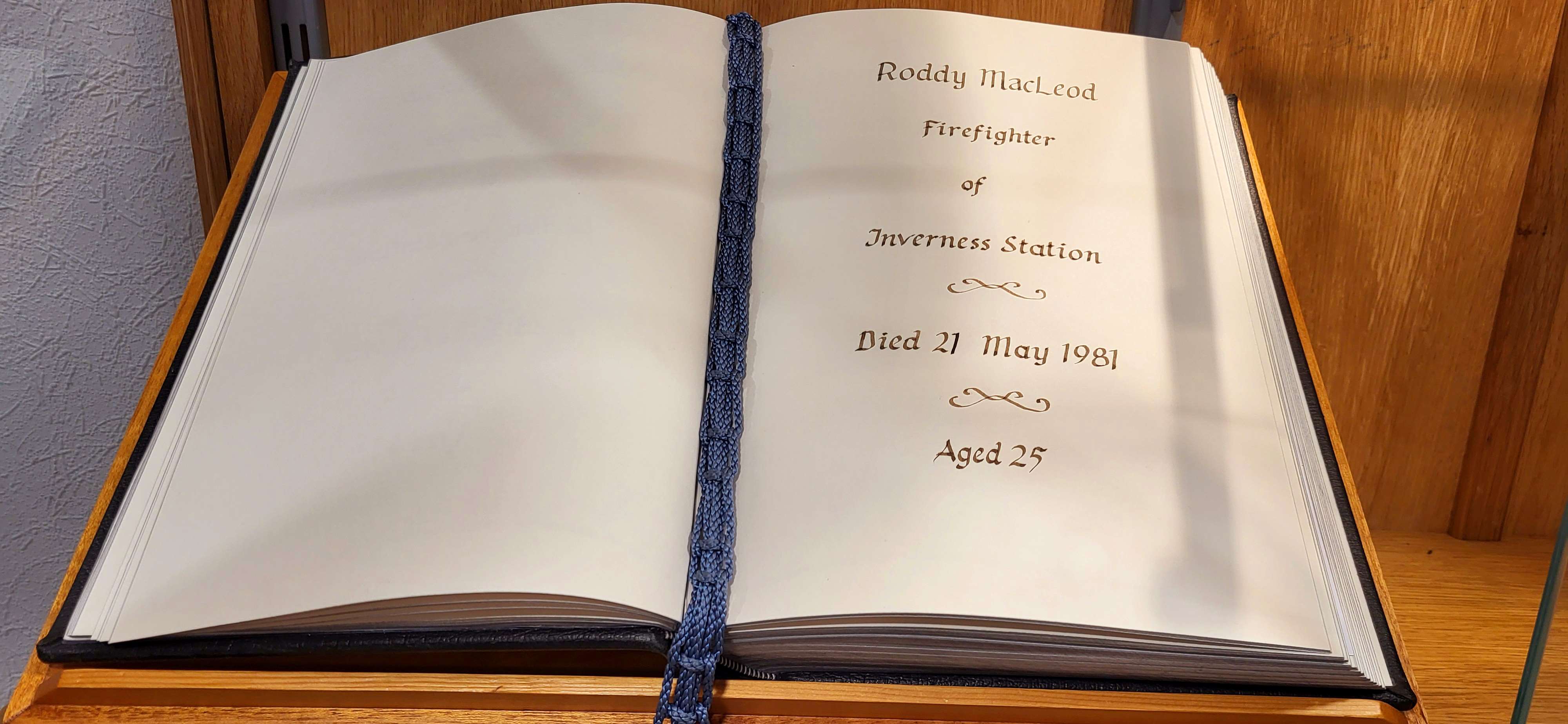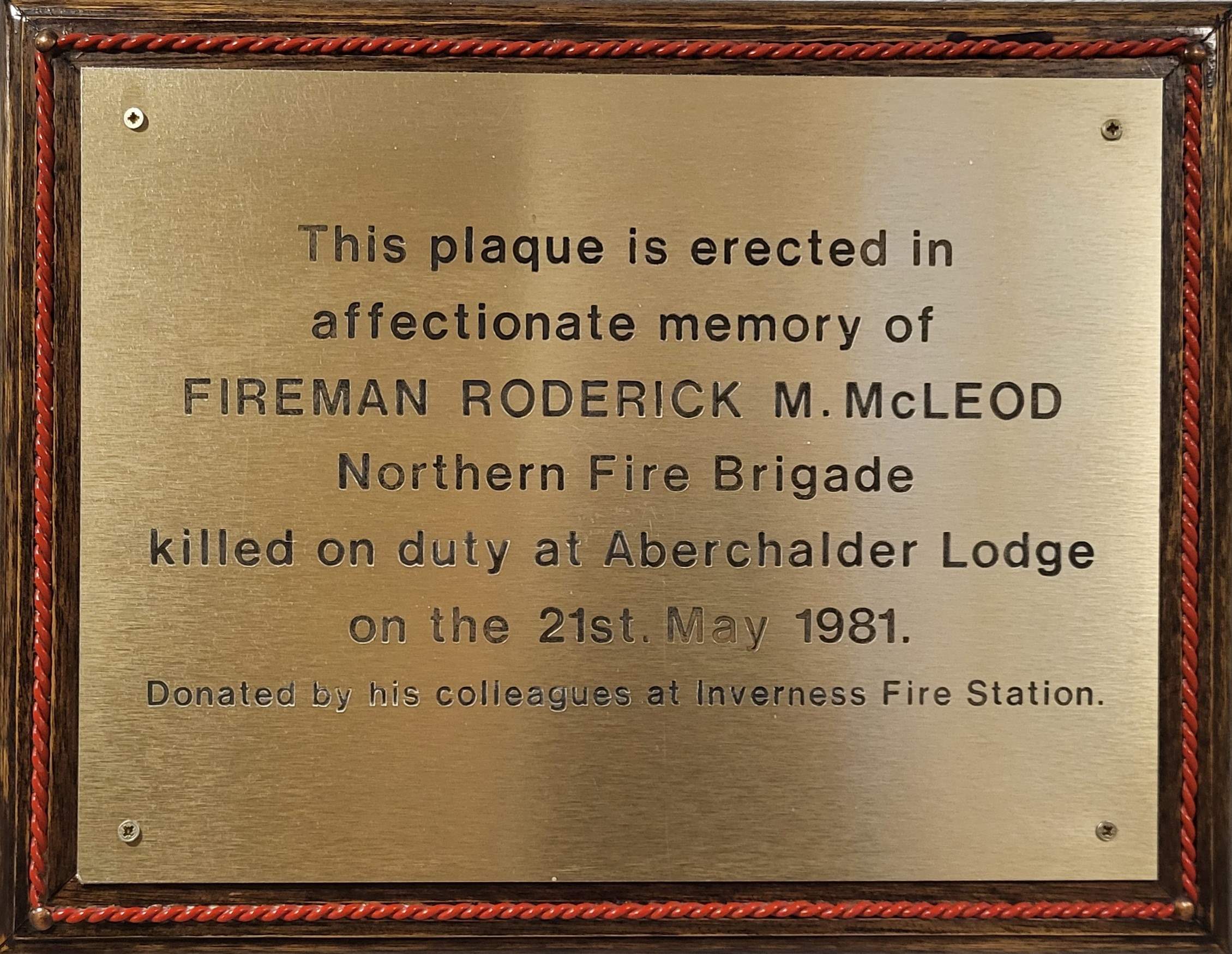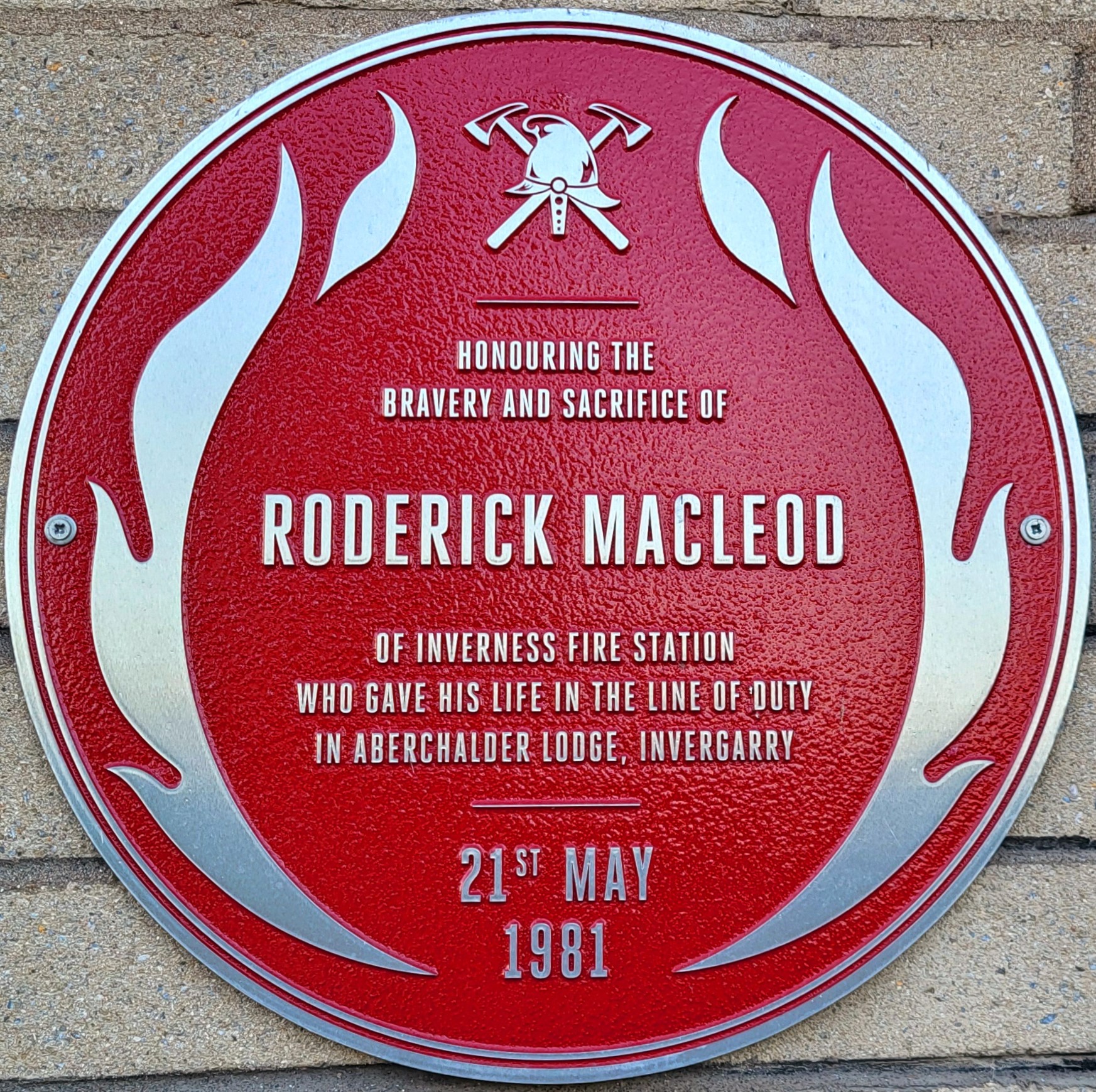
Fireman Roderick (Roddy) MacLeod of Inverness was killed by falling beams at Fort Augustus on 21st May 1981.

Book of Remembrance in Inverness Fire Station. Photo from Inverness Fire Station.

Plaque in Inverness Fire Station. Photo from Inverness Fire Station.

FBU Red Plaque outside Inverness Fire Station, unveiled 17/5/2024. Photo from Inverness Fire Station.
21/5/1981 17-55
Call out to Aberchalder Lodge. West gable well alight on arrival. Used hose reel
and drew water by Alcon from burn 100’ below the house. Able to clear much
furniture out of the building as unable to control the blaze spreading along the
roof space. Inverness arrived at 18-40 and raised more water. Fort William also
on scene. Major attempt to stem roof fire spreading to lower floors was hampered
by hot cinders falling down wall space and fire was breaking out all over the
place. By 19-30hrs almost under control when ceiling of 1st floor
crashed down and trapped Inverness fireman under beams, slates and wet plaster
and cinder. Despite efforts to release him, he was dead when eventually removed
from the room. Meanwhile fire had taken a fresh grip and by 22-00hrs was brought
finally under control but the house was virtually a write off. Returned 23-00hrs
exhausted. 9 attended. The “boys” had done a marvellous job under difficult
conditions and won justifiable praise for their efforts. Certainly the worst
fire since Ceannacroc Lodge in 1949.
(Fort Augustus Station Log Book)
LODGE FIRE CLAIMS LIFE
Inverness fireman killed at Invergarry
By JIM LOVE
<PHOTO> Kathy MacKenzie and
Jenny Cooper who fought the fire until firemen arrived.
<PHOTO> A pillar of smoke rises from the centre of the fire hit Aberchalder
Lodge.
<PHOTO> Firemen tackle the blaze which claimed the life of one of their
colleagues.
An Inverness fireman died last night after flames swept through an isolated
Highland guest house.
The dead man was one of four crews called to the blaze at Aberchalder Lodge,
four miles from Invergarry.
Last night, as the Northern Area Firemaster, Mr William Shand, supervised the
operation at Aberchalder, his deputy, Mr Donald Grant, confirmed that one of the
Inverness based fireman had been killed. Police and fire officers had gone to
inform relatives, he said, and the identity of the dead man would be released
later.
The outbreak was discovered by 22 year old housemaid, Jenny Cooper, as she was
hanging out washing behind the 19th century mansion owned by Mr
Russell Ellice and run by his daughter, Miss Jean Ellice.
“I saw smoke coming from the roof and ran and found Kathy MacKenzie, a daily
help,” Miss Cooper said. “We raced up the stairs and found the rooms were full
of smoke. We shouted for help and two local men, Donnie Johnstone and Donnie
MacDonald, who were working in the grounds came to see what was happening.
“One of them ran to phone the fire brigade and the rest of us broke open the
lodge’s fire extinguishers and tried to put out the flames.
“We were still trying to put out the blaze when the police and firemen arrived.”
Miss Ellice is on holiday and the only guests in the lodge, Mr and Mrs J.
Sheldon, a middle aged couple from 12 Cheviot Road, Paisley, were not in the
building when the fire broke out. They arrived to find the two storey building
ablaze and were found alternative accommodation at the nearby Glengarry Castle
Hotel. They have lost their belongings and last night were too upset to talk
about the fire.
In Miss Ellice’s absence the lodge was being looked after by a caretaker, Mr
James Henderson, and his wife. They were at Inverness for the day and arrived
back at Aberchalder to find the house in flames.
Police were first on the scene and they helped the two employees to fight the
flames until Fort Augustus firemen arrived. Two units from Inverness and another
from Fort William were sent to assist.
Estate workers managed to rescue most of the most valuable furnishings in the
lodge.
Mrs Isobel Service, wife of the estate gamekeeper, said: “We managed to clear
the drawing room where the majority of the most valuable paintings, china and
furniture were located.”
(The Press and Journal, Friday May 22 1981. Front Page.)
DEAD FIREMAN NAMED
The dead fireman was later named as Mr. Roderick MacLeod
(25), 51 Druid Road, Inverness. He was married with no children and had four
years’ service with Northern Brigade.
Mr. Grant said Mr MacLeod and Station Officer Donald Craig had been inside the
building when the floor above them collapsed on top of them, Mr. Craig was
unhurt.
Two hours later firemen succeeded in getting the blaze under control. The lodge
had been burning for more than five hours.
Fireman MacLeod is only North fireman to have died inside blazing building as
far as Mr. Shand can recall.
A Lewis man Mr Macleod formally served in the Merchant Navy.
Mr Shand said the building was well alight by the time the first firemen – from
Fort Augustus – arrived. “The flames had tremendous hold and were coming through
the roof.”
Northern Area Fire Service Headquarters received alarm call at 5.40 – 20 minutes
before Mr. MacLeod and his colleagues were due to go off shift.
(Newspaper cutting)
Joist that killed fireman was weak, inquiry told
<PHOTO> Inverness fireman Mr Roderick MacLeod, who died in a blaze at Aberchalder Lodge, Invergarry, pictured in action at a fire.
A Young Inverness fireman was killed when a ceiling with
an unusually weak joist structure crashed on top of him during a blaze, a fatal
accident inquiry heard yesterday.
Fireman Roderick Macleod (25), 51 Druid Road, Inverness, was trapped face down
by a heavy beam under a pile of rubble during the blaze at an Inverness-shire
guest house.
Mr Macleod had been one of a Northern Fire Brigade team sent to tackle the fire
at Aberchalder Lodge, Invergarry, on May 21.
The inquiry at Inverness Sheriff Court heard that the fire, which began in an
upstairs bedroom, was discovered by staff at about 5-30 p.m. It was initially
tackled by volunteer firemen from Fort Augustus who were later aided by units
from Fort William and Inverness.
Station Officer Donald Craig (38), Inverness, said that at about 8 p.m. the fire
was under control and they were carrying out damping down operations. He and Mr
Macleod went into the ground floor living room where there was a slight flare up
in a corner.
Station Officer Craig said: “we were just inside the door – far enough to get at
the flames with a hose. Fireman Macleod was holding the hose and he was standing
further in than I was.
“We were there for about a half minute. Then there was just this tremendous bang
and a loud crash. I got a rap on the small of my back and I fell face outwards
into the hallway. From below my knees, I was inside the door and under debris
and I could feel hot embers in my hair. I managed to push myself into the hall.”
He said that firemen dug into the room with their bare hands and then shovels to
get Mr Macleod. He was found under beams which were too heavy to lift and
hydraulic jacks had to be used.
Station Officer Craig said that generally the safest place to fight a fire in a
room was from the door, and a ceiling normally collapsed in the middle or at the
outside wall. At the time they entered the room there was no sign of danger.
He recalled that most of the beams which fell had been unaffected by fire.
Part time Fort Augustus Station Officer Father Angus Watson said he was in the
room when Mr Macleod was found. He felt for a pulse but could not find one.
GP for the area Dr William Macrae unsuccessfully battled for 10 minutes to
revive Mr Macleod. The cause of death was later found to be asphyxia as the
result of an accident.
Retired divisional commander with the fire brigade at Inverness Mr John Howie
was in charge at the scene.
A few minutes before he had been in the living room and found it intact. He said
normal practice was to fight a room fire from the doorway, which was the safest
area.
Hr Howie said he later discovered a trim joist structure above the doorway of
the room, which is weaker than the usual building method.
This type of joist is a beam that is checked into a crossbeam rather than
resting on a wall as normal. A trim joist was usually found only where there was
a fireplace or obstruction. He was surprised to find it at such a point in a
house which was about 100 years old.
Mr Howie thought a joist in the corner being burned through had caused a shock,
which then caused the trim joist to collapse because it was the weakest area.
He felt that if there had been a normal joist at the doorway the ceiling would
have collapsed at the centre leaving the firemen in a safe position.
Forensic expert Dr William Gibb, Glasgow, carried out an investigation later at
the scene. He said the most likely cause of the blaze was an electrical fault
under the flooring of the bedroom which was directly above the living room.
He said the insulation on the cable seemed to have failed and the short ignited
combustible material under the floor. The fire could have been going for about
two hours before it was discovered.
Sheriff William Fulton returned a formal finding but added: “It is quite clear
that the fire fighting operations were carried out swiftly and efficiently with
due regard to the safety of those involved.
“But it was particularly unfortunate that Mr Macleod should have been trapped
and killed by an accident which was entirely unexpected given the circumstances
and the structure of the building.”
<3 PHOTOS> Donald Craig, Father Watson and John Howie. (heads only)
(Pages 1 and 2 of a newspaper cutting).